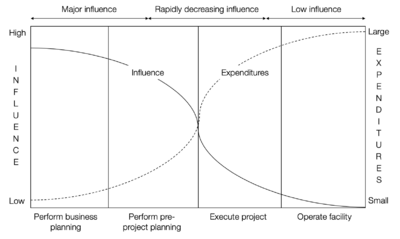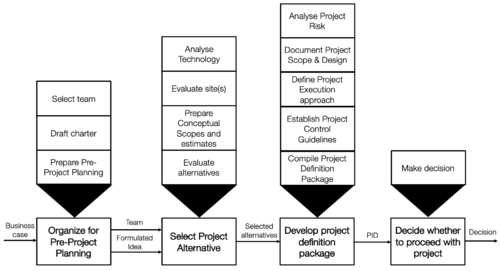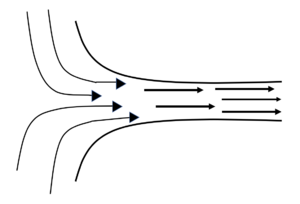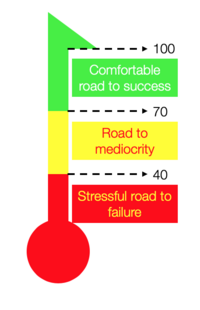Project Initiation Management in construction
Contents |
Abstract
This article will give an introduction to Project Initiation Management or Front-End management mainly in the construction industry. This includes a general introduction of how project initiation management is defined in literature and the purpose of doing good project initiation management will be presented. Project Initiation Management is all about starting projects in the right manner, defining the project phase and objectives and lastly authorising the project manager to proceed with the project [1]. This consists of making sure that stakeholders expectations are managed and aligned with the project objectives [2], but also taking time to define the project description to a big extent. Some of the practices to ensure that a project is being initiated in the best possible way will also be presented and discussed in the subsequent sections. Lastly the importance of alignment in the initiation of projects is presented to give an idea how this can make it or break in the early phases of a project, and additionally a tool to determine the alignment is presented. Many times projects are being initiated even though they are not described and defined sufficiently, which can, and often does, lead to very poor project management of projects. This can be avoided by following some of the recommendations in this article, which seek to define a project to a big degree which will help in the decision-making on whether to continue with a project, and if continued, the project management.
Project Initiation Management
Project Initiation Management has many different names and definitions in litterature. This section will aim to collect the different definitions and names throughout literature, and will subsequently define the important aspect learned from these definitions. Furthermore a description of the purpose of doing good project initiation management will be presented. Lastly project initiation management used in construction projects will be assessed.
Synonyms of Project Initiation Management
- Front-end planning
- Pre-Project planning
- Project Development process
- Project Start-up
- Early Planning
- Front-end loading
- Conceptual planning
Definitions in literature and important aspects
- DS/EN ISO 21500: Guidance on project management: "The initiating processes are used to start a project, to define the project phase or project objectives and to authorize the project manager to proceed with the project work." [1]
- Axelos, Managing Successful Projects with PRINCE2: "Initiating a project is aimed at laying down the foundations in order to achieve a successful project. Specifically, all parties must be clear on what the project is intended to achieve, why it is needed, how the outcome is to be achieved and what their responsibilities are, so that there can be genuine commitment to it ... to decide whether or not the project is sufficiently aligned with corporate, programme management or customer objectives to authorize its continuation. If, instead, the organization proceeds directly from starting up a project ...then it may risk committing significant financial resources to a project without fully understanding how its objectives will be achieved." [3]
- Project Management Institute:"The Initiating Process Group consists of those processes performed to define a new project or a new phase of an existing project by obtaining authorization to start the project or phase. The purpose of the Initiating Process Group is to align the stakeholders’ expectations and the project purpose, inform stakeholders of the scope and objectives, and discuss how their participation in the project and its associated phases can help to ensure their expectations are met." [4]
- Construction Industry Institute: "... the process of developing sufficient strategic information with which owners can address risk and decide to commit resources to maximise the chance for a succesful project." [5]
- AMA handbook of project management:"The important point is that work is done (sometimes a substantial amount) on developing the project definition before and in the process of leading up to the submission of the project proposal, that is, the formal request to sanction full implementation of the project ... focuses on the project in its context, particularly on early definition of the conditions for stakeholder success. Within this framework, project, program, and even aspects of portfolio management are encompassed." [2]
From these definitions the following important aspects of project initiation management are listed below
- Define the project phase: This will cover a lot of the managerial processes from Project Management such as Risk Management, budgeting and scheduling. Furthermore a project charter is made to formally authorize the project, identify the project manager responsibilities and to document business needs such as expected deliverables and economic aspects of the project [1].

- Define project objectives: This part of the project initiation management is understood as a very important aspect for project success across the standards listed above. If the project objectives are clear and concise, this will ensure that every stakeholder knows why they are doing a project, which will increase the likelihood of success. Another important aspect of defining these objectives is that they need to be aligned with the organisational objectives.
- Stakeholders: Defining clear project objectives in collaboration with the stakeholders involved in the project, would ensure that their expectations and the project purpose aligns. Furthermore the identification of the stakeholders implied by this project should be analysed and a stakeholder register should be put together.
- Authorizing the full implementation: This step is the last step of project initiation management, and should lead to either continuation or termination of the given project. It is important for this decision to be based on a solid foundation of knowledge, which would require that the previous points are well-described, otherwise not starting the project might have been better, than continuation of an ill-defined project.
From the above points it is seen that project initiation management, involve a lot of different aspects of project, programme and portfolio management [2]. Only some of these features will be described in this article. The purpose of doing good project initiation management is as mentioned above the need to make the best possible decision based on the given information at that stage. This will eventually lead to the Project Management Office choosing the right project fit for their organisational objectives and managing this project as best as possible. From Figure 1 it can be seen that the early stages of a project has a big influence on the final outcome. The curve named Influence reflect the organisation's ability to affect the project outcome. From the diagram it is seen that it is much easier to influence the project outcome during the pre-project planning as the expenditure is relatively small. This accentuates the need for good project initiation management, as it will probably save a lot of money in the long run. Often the project initiation management process is cut short because of resistance from both business and technical staff as the perception is that a lot of money is spend on project that potentially will not get approved or that the extensive planning takes too much time. The learnings do indicate that this is not the case, as both probability of project failure is decreased, there is improved cost predictability and the business and operational goals are more easily achieved [5]
Project Initiation Management in construction
In this section the processes that needs to be addressed in order to achieve succesfull project initiation management in construction projects is further clarified. The different processes involved in the project initiation management can be viewed in Figure 2 and will be further analysed in this section. This is based on the findings and theory from the Construction Industry Institute [5]. The model shown in Figure 2 embrace the project initiation from start to the phase where a final decision is made whether to proceed with the project.

The different processes will be outlined below. For more comprehensive detailing, review "Beginning a Project the Right way" [5] and "Pre-Project Planning Handbook" [6]
- Organize for Pre-Project Planning
- Select team: The Project Initiation Management team is selected and developed. The team should include skilled and experienced members, within both business and project management, as well as expertise within the given field.
- Draft charter: The mission and responsibilities are defined and the original concept and business case is further refined into a workable project-based concept. It is important that the charter objectives are aligned with the involved stakeholders. This charter would also include major milestones and the funding needed.
- Prepare Pre-Project Planning Plan: In this step the methods and resources needed for completing the project initiation is defined and documented. This includes budgeting, project outline and responsibilities for all members of the project initiation team.
- Select Project Alternatives
- Analyse Technology: This step involves evaluating the current and emerging technologies compatibility with the corporate business and operations needs. Furthermore, Scale-up problems and the technology's application should also be addressed. This element in the project initiation mangagement can have a big impact on the final outcome, and therefore careful consideration is needed when making the choice of technology.
- Evaluate sites: Different sites are evaluated that meets the clients needs. This can be based on different criteria such as access to raw materials, labor costs, utilities or market area. Additional constraints such as legal, regulatory and social issues are also needed to be taken into account.
- Prepare Conceptual Scopes and Estimates: The information from the different alternatives are gathered and shown in a format that permits a valid comparison based on the project objectives. This includes milestone schedules and resource requirements for each of the alternatives.
- Evaluate Alternatives: The decision maker in collaboration with the team makes the final decision on which project to choose, that is the most advantageous for the organisation. This has to be done using systematic analysis of the sites and the available technology. This can for example be done using a decision matrix.
- Develop a Project Definition Package
- Analyse Project Risks: Risk Management is a very big and important topic of Project Management and needs to be carefully understood. This step is about identifying, analysing, categorising risks as means to minimise the impact of risk on the project success. Incorporation of risk management strategies are also a part of this step.
- Document Project Scope and Design: The scope should be well-defined at this step and the project design should reach a level where the associated risks with regards to execution and operation are minimised.
- Define Project Execution approach: In this steps the methods to perform the detailed design, procurement, validation and construction are evaluated and documented. This includes delegating the specific roles and responsibilities. This document should address the how the project is executed, in regards to the methods, procedures and resources.
- Establish Project Control Guidelines: This step is about defining how to control the project during the execution. This involves CPM schedules, procurement schedules, safety guidelines. Moreover aspects such as change management and work breakdown structure (WBS)
- Compile Project Definition Package: In this step, the work done in the above-mentioned points are compiled into a definition package, which describes the road map for project execution and a project authorisation package, which is an executive summary for the decision maker. The project authorisation package will be used to make a funding decision. It is recommended that 10-25 percent of the total design effort is completed and documented at this point [6]. This is sometimes also referred to as Project Initiation Documentation (PID) [3]. A method to measure the documentation and definition level could be by using the Project Definition Rating Index (PDRI) [7], which will give an indication of how well the stakeholders perceive the project initiation management.
- Decide whether to proceed with project
- Make decision: In this final step, the documentation compiled in the previous step is assessed to determine if this aligns with organisational objectives and needs. This process aims to test the validity of the business, technological and operational goals. Furthermore, an assessment of the probability of achieving these objectives is made. This decision will end in either execution of the project or termination or shelving.
By following the above mentioned steps, extensive work is done before choosing a project, which would ensure that the right project is initiated in the best possible way.
Alignment

When working together on large construction or infrastructure projects often this includes many stakeholders. If the project needs to be a success the alignment of these stakeholders is vital. The Construction Industry Institute defines Alignment as: "The condition where appropriate project participants are working with acceptable tolerances to develop & meet a uniformly defined & understood set of project objectives". This is illustrated in Figure 3, where the different stakeholders are represented as arrows. These stakeholders initially have many different ways of viewing the project objectives and it is in the interest of the PMO to align these views as they otherwise increase complexity. As shown in the Figure 3 there is a need for a uniform set of boundaries, to align a team. The alignment will keep teams in the same direction which in the end would lead to a higher productivity. This direction needs to be well defined, so that every team member knows the end goal. If the different processes listed in the previous section are followed this would lead to well-defined objectives, which would make alignment much easier.
In "Alignment During Preproject Planning"[8] 10 critical issues of alignment were observed. These are listed below and a short explanation is given.
- Stakeholders are appropriately represented on the project team: The project team should include representatives from the different stakeholders, this includes construction, operations, business etc.
- Project leadership is defined, effective, and accountable: The management group should use effective Project Initiating Management methods to ensure that team members commit to the project objectives. This requires a vast knowledge about the best practices in Project Initiation Management. Furthermore the responsibility should be clearly defined.
- The priority between cost, schedule, and required project features is clear: This priority need to be clear for all team members, as this will assist in making the right decision aligned with management's thoughts, which will also save time.
- Communication within the team and with stakeholders is open and effective: There should be clear and open communication between all team members. This should be done by using new communication technology, which improves information sharing. Furthermore concepts such as GO-RI-MA (Go-Ring-Mail) could be introduced to decrease misunderstandings.
- Team meetings are timely and productive: This includes providing agenda, assigning meeting roles and evaluating the meeting. The purpose of these meetings should be to inform team members about the ongoing process and gain valuable insights as well.
- The team culture fosters trust, honesty, and shared values: These values are heavily influenced by the organisational culture, but as a team leader, one should make sure that team members are open about the concerns and opinions towards the project.
- The preproject planning process includes sufficient funding, schedule, and scope to meet objectives: If the Project Initiation Management is not given sufficient funding, this will results in poor planning and the wrong projects. Therefore it is important to demand sufficient funding so that team members are comfortable both regarding cost and time
- The reward and recognition system promotes meeting project objectives: Team members and different stakeholders needs to be recognised so that they are more eager to meet the project objectives.
- Teamwork and team building programs are effective: For the team to work most effectively, a strong teamwork feeling needs to be present. This can be done through work-shops or team building exercises.
- Planning tools (e.g., checklists, simulations, and work flow diagrams) are effectively used: It is important that the most effective tools are used for Project Initiation Management. This cherishes open communication and therefore the whole team should be involved in the use of these tools.
Alignment Thermometer
As demonstrated in the previous section, there are a number of different alignment problems, which could lead to project failure if they are not addressed in the early stages of the project. A way to measure the alignment in projects are shown in this section. This tool called: "Alignment Thermometer" was developed by Construction Industry Institute [9] and is shown in Figure 4. This tool can be used to measure the alignment both before and during the project. The tool is used by following the 3 steps shown below:
- Circle the number corresponding to the level of agreement (1=strongly disagree, 5=strongly agree) in Table 2
- Write the circled number in the "score" column and add together the total score
- Plot the total score on the thermometer seen in Figure 4
By doing this the project score will reveal the degree of alignment in the project ranging from, comfortable road to success to stressful road to failure. If a project is scored in the lowest third of the thermometer, significant measures should be taken to make sure that the project is coming back on track, alternatively a different project should be chosen.

| Project Name | Level of agreement | |||||
|---|---|---|---|---|---|---|
| Alignment Issues | 1 | 2 | 3 | 4 | 5 | Score |
| 1. Stakeholders are appropriately represented on the project team. | 0 | 3 | 5 | 8 | 10 | |
| 2. Project leadership is defined, effective, and accountable. | 0 | 3 | 5 | 8 | 10 | |
| 3. The priority between cost, schedule and
required project features is clear |
0 | 3 | 5 | 8 | 10 | |
| 4. Communication within the team and with
stakeholders is open and effective. |
0 | 3 | 5 | 8 | 10 | |
| 5. Team meetings are timely and productive. | 0 | 3 | 5 | 8 | 10 | |
| 6. Our team culture fosters trust, honesty, and shared values. | 0 | 3 | 5 | 8 | 10 | |
| 7. The PPP process includes sufficient funding, schedule and
scope to meet our objectives. |
0 | 3 | 5 | 8 | 10 | |
| 8. Reward and recognition systems promote meeting
project objectives. |
0 | 3 | 5 | 8 | 10 | |
| 9. Teamwork and team building programs are effective. | 0 | 3 | 5 | 8 | 10 | |
| 10. Planning tools (e.g., checklists, simulations and
work flow diagrams) are effectively used. |
0 | 3 | 5 | 8 | 10 | |
| Total score | ||||||
Limitations
When dealing with Project Initiation Management it should be noted that even when doing a proper and thorough investigation there are certain limitations. Even though a lot of planning is done beforehand, something unforeseen could happen, which could have critical implications on a project. This includes both the selection of a project as well as the management of it. Furthermore the actual managing of a project and securing alignment can be planned out and defined extensively, but if management can manage to drive a project forward, and get stakeholders to work towards the same goal this work could be for nothing.
Annotated Bibliography
- Beginning A Project The Right Way
- This work by the Construction Industry Institute have proved a valuable source to how the Project Initiation Management is incorporated in construction and infrastructure projects. The book contains concrete evidence and data on how good Project Initiation Management is important for a successful project, both in terms of cost, time and quality.
- Managing Successful Projects with PRINCE2 2017
- Chapter 16: Provides an overview of which processes is need when initiating a project. This includes the needed documentation and activities, within change, risk and quality management.
- Guide to the Project Management Body of Knowledge (PMBOK® Guide) (6th Edition).
- Part 2, Chapter 2: This standard gives a broader description of what is needed of the project initiation group. This includes what is needed in the project charter as well as when identifying stakeholders
- Alignment During Preproject Planning
- This article gave a useful insight to the alignment problems experienced by industry professionals. Furthermore the introduction of the 10 alignment issues and the alignment thermometer, gave a concrete way to measure alignment in a project.
References
- ↑ 1.0 1.1 1.2 DS/EN ISO. 21500: Guidance on Project Management. 2nd ed. ISO; 2013.
- ↑ 2.0 2.1 2.2 Dinsmore P, Cabanis-Brewin J. The AMA handbook of project management. 4th ed. New York: AMACOM; 2014. p.35-44
- ↑ 3.0 3.1 AXELOS A. Managing Successful Projects with PRINCE2 2017 Edition. London: The Stationery Office Ltd; 2017. p. 195-212
- ↑ Project Management Institute, Inc. Guide to the Project Management Body of Knowledge (PMBOK® Guide) (6th Edition). Project Management Institute, Inc. (PMI); 2017.
- ↑ 5.0 5.1 5.2 5.3 5.4 5.5 Gibson G. Pre-project planning: Beginning A Project The Right Way. 1st ed. Austin, Texas: Construction Industry Institute; 2004.
- ↑ 6.0 6.1 Gibson G. Pre-Project Planning Handbook. Special Publication 39-2. Austin, Texas: Construction Industry Institute; 1995.
- ↑ Gibson Jr. G. Project Definition Rating Index: Building Projects. 3rd ed. Austin, Texas: Construction Industry Institute; 2008.
- ↑ 8.0 8.1 Griffith A, Gibson Jr. G. Alignment During Preproject Planning. Journal of Management in Engineering. 2001;17(2).
- ↑ 9.0 9.1 9.2 Construction Industry Institute (CII). Alignment during preproject planning. Implementation Resour. 113-3,Austin, Tex, 1997.